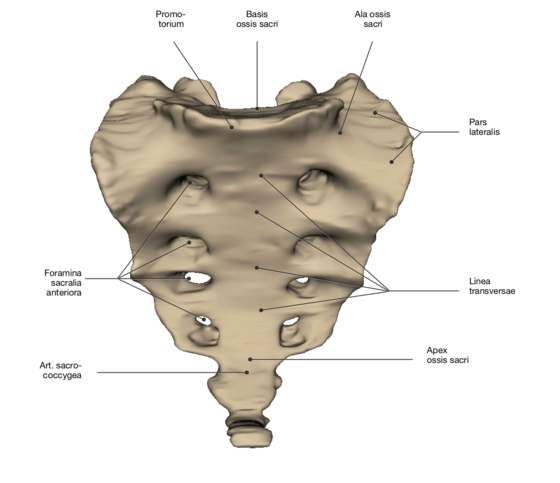Translations:Kreuz- und Steißbein/2/en: Unterschied zwischen den Versionen
Becher (Diskussion | Beiträge) (Die Seite wurde neu angelegt: „'''The sacrum (Os sacrum)'' is a triangular bone and originally consists of '''five independent sacral vertebrae''' (<i>Vertebrae sacrales</i>, S1-S5). File…“) |
Becher (Diskussion | Beiträge) |
||
| Zeile 1: | Zeile 1: | ||
| − | '''The sacrum (Os sacrum)'' is a triangular bone and originally consists of '''five independent sacral vertebrae''' (<i>Vertebrae sacrales</i>, S1-S5). | + | '''The sacrum (Os sacrum)''' is a triangular bone and originally consists of '''five independent sacral vertebrae''' (<i>Vertebrae sacrales</i>, S1-S5). |
[[File:KreuzVentral.png|560px|right|ventral view of the sacrum and coccyx]] | [[File:KreuzVentral.png|560px|right|ventral view of the sacrum and coccyx]] | ||
| − | It was formed by the fusion of the five cross vertebrae and the intermediate intervertebral discs (<i>Discus intervertebrales</i>). It belongs to the immobile part of the [[Wirbelsäule|spine]]. The sacrum has a forward concave surface (<i>Facies pelvina</i>), the dorsal surface (<i>Facies dorsalis</i>) is convex. The tip of the sacrum (<i>Apex ossis sacri</i>), positioned caudally, is connected to the coccyx. Dorsally of the sacrum, there are five bone ridges (longitudinal ridges), which emerged from the spinous, articular and transverse processes. Between the <i>foramina sacralia anteriora</i> are the four transverse lines of the fused vertebral bodies (<i>line transversae</i>). Furthermore, the passage (<i>Foramina sacralia pelvina</i>) for the spinal cord nerves (<i>spinal nerve</i>) is located there.<br> | + | It was formed by the fusion of the five cross vertebrae and the intermediate intervertebral discs (<i>Discus intervertebrales</i>). It belongs to the immobile part of the[[Special:MyLanguage/Wirbelsäule|spine]]. The sacrum has a forward concave surface (<i>Facies pelvina</i>), the dorsal surface (<i>Facies dorsalis</i>) is convex. The tip of the sacrum (<i>Apex ossis sacri</i>), positioned caudally, is connected to the coccyx. Dorsally of the sacrum, there are five bone ridges (longitudinal ridges), which emerged from the spinous, articular and transverse processes. Between the <i>foramina sacralia anteriora</i> are the four transverse lines of the fused vertebral bodies (<i>line transversae</i>). Furthermore, the passage (<i>Foramina sacralia pelvina</i>) for the spinal cord nerves (<i>spinal nerve</i>) is located there.<br> |
<br> | <br> | ||
Aktuelle Version vom 2. Januar 2020, 14:02 Uhr
The sacrum (Os sacrum) is a triangular bone and originally consists of five independent sacral vertebrae (Vertebrae sacrales, S1-S5).
It was formed by the fusion of the five cross vertebrae and the intermediate intervertebral discs (Discus intervertebrales). It belongs to the immobile part of thespine. The sacrum has a forward concave surface (Facies pelvina), the dorsal surface (Facies dorsalis) is convex. The tip of the sacrum (Apex ossis sacri), positioned caudally, is connected to the coccyx. Dorsally of the sacrum, there are five bone ridges (longitudinal ridges), which emerged from the spinous, articular and transverse processes. Between the foramina sacralia anteriora are the four transverse lines of the fused vertebral bodies (line transversae). Furthermore, the passage (Foramina sacralia pelvina) for the spinal cord nerves (spinal nerve) is located there.
